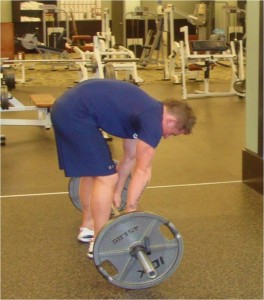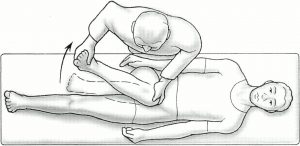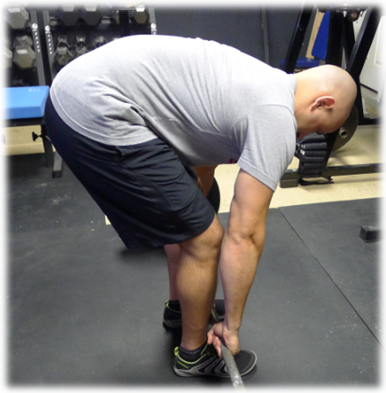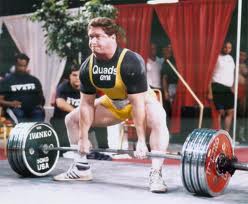Maybe You Shouldn’t Deadlift From The Floor
A few months ago, I wrote a piece that outlined a lot of the individual variances in hip structure, and how they could affect your ability to squat to depth or lack thereof. It was very well received, and I’m happy it got a conversation started about individualizing stance width, depth, and even asymmetric set up to account for an individuals’ unique biomechanics and alignment considerations.
One consideration that speaks to this concept of individual abilities based on hip anatomy is the ideal of deadlifting from the floor. For instance, pretty much everyone does it, whether they have the requisite mobility to do it or not. Everyone seems to think that if you can’t deadlift from the floor without problems that you just need to work on your mobility, suck it up and be a man, or hang your head in shame for being an unevolved human being. These are reasons why the internet sucks holy hell, because people will actually talk to each other like this.
Sure, some people will see improvements in their ability to pull wheels off the floor with some focused work on mobility and core control, plus they may just have to learn the positioning and the ability to be there while developing tension in that position to succeed.
But some people won’t.
To set up for a deadlift, depending on the individual’s height you may require anywhere from 115-130 degrees of hip flexion. This is also dependent on torso length relative to leg length, and also in whether the individual sets up with a high hip or low hip set up, but suffice it to say the hip flexion angle is pretty sufficient. In a conventional stance, that angle occurs in an almost entirely sagittal plane alignment, which is also a common zone of hip impingement.
If an individual happens to have more of a retroverted acetabulum that limits movement into deep flexion past 110 degrees, more of a center-edge angle that could predicate bone to bone contact in this position compared to less of a center-edge angle, which would allow more motion before bone to bone contact occurs.
Because of this potential structural limitation through hip flexion, some people may not be able to get into position to pull the weight from the floor without trying to find motion somewhere else. The great thing about the body is it always finds a way to do the job, but there’s always a cost of doing business.
One way the movement can occur if the person runs out of hip flexion range of motion is to add in some lumbar flexion range to make up the difference. This is a common situation where the low back looks like it’s rounding, or even developing a hinge at one or two vertebral segments. When looking at the low back directly, it looks like wings or fins riding along the spine or like instead of a smooth bend the spine has a sudden kink in it at one spot.
Bret Contreras wrote an awesome article on how involving upper back rounding was different from low back rounding, especially for powerlifters, and also covered a lot of other major and minor details in setting up and execution.
There’s a couple of reasons why rounding the low back on set up could be a bad idea. First, if the low back is flexing to meet the bar, one of two things will happen when you pull the bar off the floor: the low back initiates the first phase of movement to get back to neutral, or it doesn’t and stays in that position, or potentially slips further into flexion. A downside of the low back initiating movement against load while in flexion is it’s now taking over the responsibility of the prime movers in the hips, making the lift slower or weaker than it should be, and also making the low back do considerably more work than it likely ever should do, which can predispose it to potential tissue failure, especially if in the presence of fatigue.
If the spine stays flexed through the movement or drifts further into flexion, the vertebral body and disc are now exposed to a magnitude of shear force 10 times greater than if it was in more of a “neutral” position (which I know is a contentious term to anatomy geeks). Shear force can cause some damage to discs, vertebral ligaments and other connective tissue, plus also tends to decrease activity of the lumbar erector spinae when in a forward flexed position. Essentially, a stretched muscle under load won’t be able to flex as hard as a shortened muscle under the same load, and in time the risk of the muscle not being able to hold the joint together goes up significantly as the magnitude of that force increases and as the reactive moment of those muscles decreases.
So the big question comes up: should someone who doesn’t have the hip anatomy to allow them to grab the bar without compensating with low back flexion even worry about pulling a bar off the floor? The plates used are typically a set height, meaning if you’re 5’0″ or 7’0″ tall you have to bend down to the same position. The person who is 5’0″ tall will pull from a position that’s almost at their knee, whereas the 7’0″ tall person will essentially be tying their shoes at the start position. No one would say someone who was a 7’0″ basketball player should deadlift from the floor since it’s such an aggressive hip position and doesn’t warrant the risk for their ability, so why do we figure a 5’10” accountant named Dave should have to pull from the floor versus from an elevated position?
In all honesty, there are only 2 sports or activities which would require deadlifting from the floor: powerlifting and olympic lifting. In both of those sports, the weight starts on the floor and you have to lift from that position, regardless of your body dimensions, height, hip anatomy, etc. For any other sport, activity, training goal, or lifestyle, deadlifting from the floor may not be necessary and could actually be counter-productive to the relative risk to benefit ratio for the individual.
In many people, a floor pull is actually a deficit pull.
So let’s say you’re in a situation where you round your low back when you go to grab the bar in a conventional stance with your feet under your hips, but you still want to deadlift off the floor. There’s a couple of potential options you could work with. One is to take a slightly modified sumo stance approach. This means setting up with a foot width stance slightly wider than shoulder width, or for many around the width of the grip you would use for bench press, grab the bar inside the feet, and pull from that position. In many cases, this more lateral stance tends to allow a more free hip motion through flexion, but also has the added benefit of shortening the lever length of the thigh acting on the low back.
You could also use a trap bar, which has a higher handle height and situates the bar more easily underneath your center of gravity and over your base of support compared to a traditional barbell.
Occasionally, because we all have some level of asymmetry in our pelvic structure, it may even warrant turning one toe out further than the other, or even having one foot set up behind the other.
Let’s say that either of these options are still not enough to counter the lack of hip mobility to grab the bar without flexing the spine. Setting the weights up on risers on the floor, either with some pads or other plates, or simply using a squat rack to do a rack pull from an elevated position would still allow the individual to train the movement within their abilities and see some overload that could develop a training effect similar to pulling from the floor but without exposing the spine to unnecessary and potentially detrimental forces.
Who knows, maybe you do just need more mobility and control over your end ranges of motion to help you get into that position. You know I got you on this:
To summarize, don’t get hung up on having to do an exercise a specific way that may not work well with your specific body anatomy, abilities, or limitations. Sometimes a slightly reduced range of motion or an altered stance can give you the same training effect you’re looking for but without the same risks. Still work on improving your abilities to expand on the potential repertoire of activities you can do, but understand there’s many different paths that can lead in the same direction.







8 Responses to Maybe You Shouldn’t Deadlift From The Floor